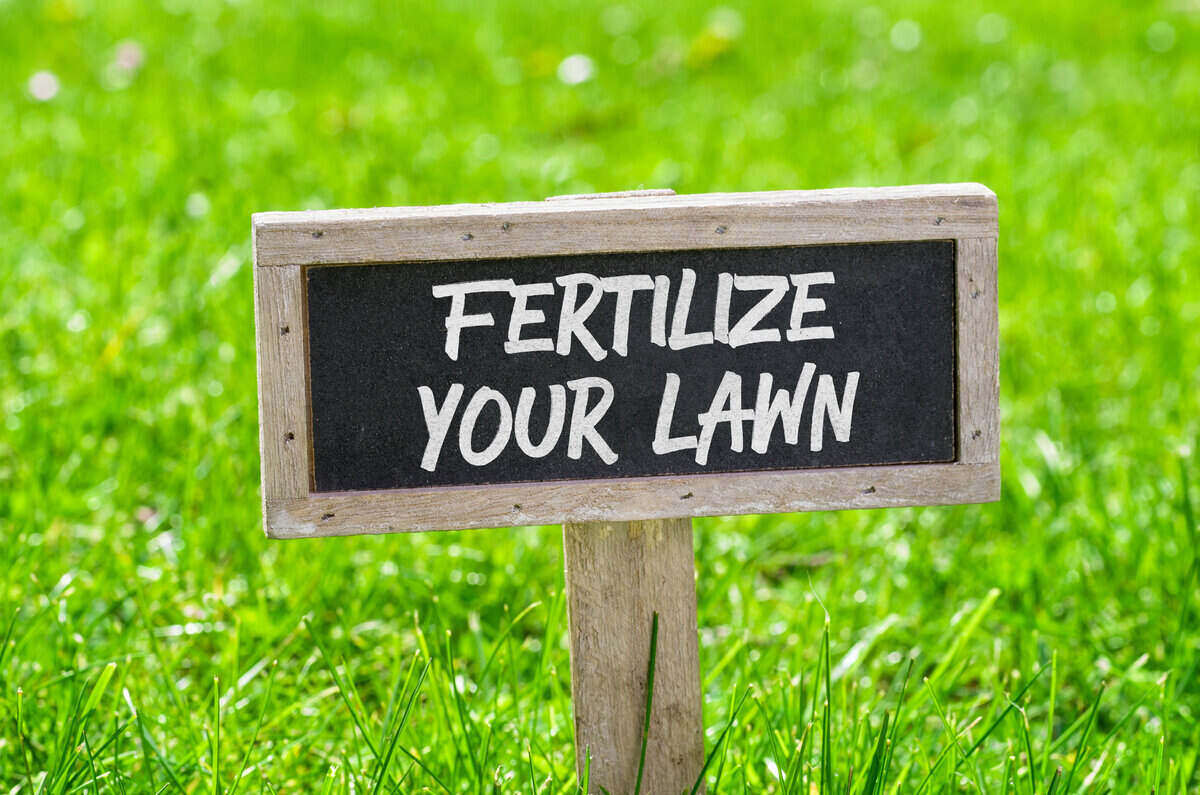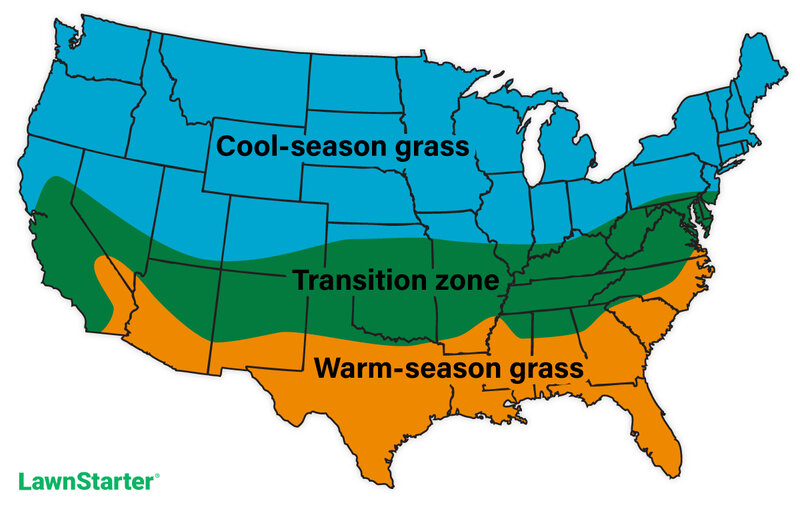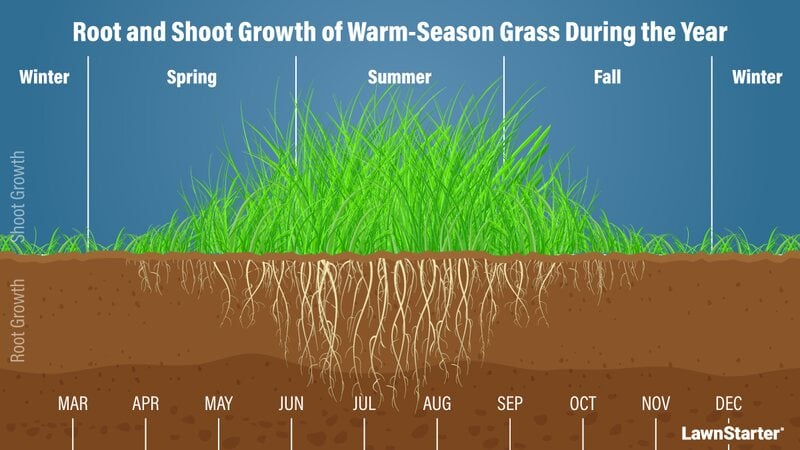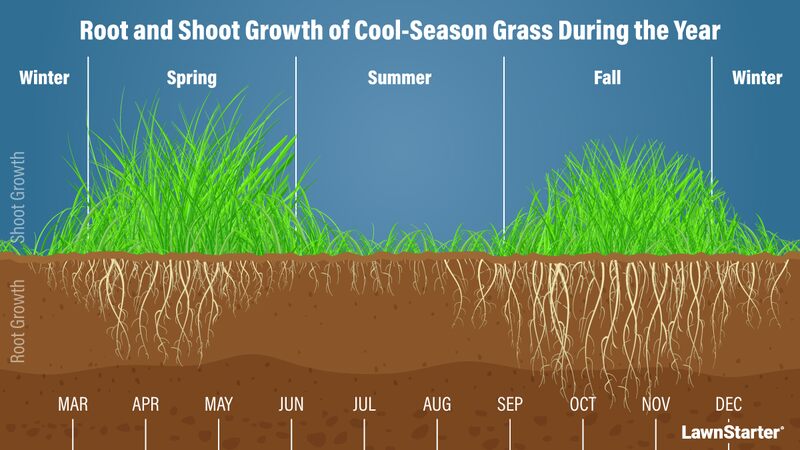
The right time of year to fertilize your lawn depends on your grass type’s growing season, but regardless whether your lawn is made up of a warm-season or cool-season grass, your first round of fertilization begins around April.
In this article we’ll walk you through when to time your rounds of fertilization for your warm-season or cool season grass so it gets the nutrients it needs to thrive from spring into fall.
Fertilization is something you can do yourself, but the complexities of soil tests, NPK ratios, and choosing the right fertilizer for your grass often leads homeowners to hire a lawn treatment pro for this spring, summer, and fall lawn care task.
Whether you DIY or hire a pro, we’ll detail your lawn fertilization schedule.

When to Fertilize Depends on Your Grass Type
The first step in knowing when to fertilize is to identify the type of grass growing in your yard.
There are two primary varieties of grass: warm-season grasses and cool season grasses.
- Warm-season grasses grow across the southern region of the U.S. (Warm-season grasses green-up earlier because it’s warmer through much of the year across the Southeast, South, and Southwest.)
- Cool-season grasses grow across the northern U.S. (Cool-season grasses don’t start green-up till after winter ends and the last frost is past.)
A third of the country is in the Transition Zone, where either warm-season grasses or cool-season grasses can grow. (See our Guide to Growing Grass in the Transition Zone.)
If you know your lawn’s grass type, read our comprehensive fertilizer guides below to ensure your lawn receives individualized care:
- When to Fertilize Fescue
- When to Fertilize Kentucky Bluegrass
- When to Fertilize Centipedegrass
- When to Fertilize Buffalograss
- When to Fertilize Zoysiagrass
- When to Fertilize Bermudagrass
When planning a fertilization schedule that works for you, it’s also important to consider soil quality and the local climate.
Soil testing determines the nutrient levels in your soil, giving you a starting point for your fertilization plan. Different climates typically impact fertilizer requirements depending on temperature and moisture levels.
Regular monitoring and adjusting based on your grass’s needs will contribute to a healthy, thriving lawn.
See Related:
— How to Use a Soil Test Kit on Your Lawn
— How to Prepare a Soil Sample (in 4 Easy Steps)
— 9 Reasons Why Testing Your Soil is Important
When to Fertilize Warm-Season Grasses

Warm-season grasses grow best in places with warm year-round temperatures. They’ll often turn brown in the winter, which means they’ve gone dormant. Depending on where you live, winter dormancy usually lasts about three to five months.
Types of warm-season grasses include:
- Bahiagrass
- Zoysiagrass
- Bermudagrass
- Buffalograss
- Centipedegrass
- St. Augustinegrass
- Carpetgrass
Feed your warm-season grass every six to eight weeks during its active growing season (see infographic above). Start your first round when soil temperatures have been holding steady at 65 degrees for a few weeks.
Follow this fertilization schedule for warm-season grasses:
- 1st round – Mid to late spring (around April)
- 2nd round – Early summer (June)
- 3rd round – Early fall (September)
Pro Tip: When it’s time for your summer feeding (the most important feeding time for warm-season grasses), add some organic fertilizer to your regular fertilizer. Whether you add manure, bone meal, or compost, this boost of nutrients can better prepare your warm-season grass for winter dormancy.
When to Fertilize Cool-Season Grasses

Cool-season grasses experience their most vigorous growth during the cooler parts of the year, particularly in the spring and fall. During this time, they’re better able to utilize available moisture and nutrients, resulting in lush, silky lawns. These grasses flourish in climates with warm summers and cold winters.
Well-known cool-season types include:
- Kentucky bluegrass
- Bentgrass
- Ryegrass
- Fine fescue
- Tall fescue
Avoid feeding your cool-season grass too early, as this will encourage leaf growth but leave the root system weaker and susceptible to damage. Be mindful of soil temperatures, which for cool-season grasses need to be around 55 degrees for successful fertilization.
Follow up with a winterizing variety six to eight weeks after your late fall fertilizer application. This is best done when your cool-season grass is still green, but has stopped growing (air temperatures will usually be in the 50- to 55-degree range.
Winterizing fertilizer is full of potassium and phosphorus to help your grass maintain strong roots in winter but low in nitrogen to prevent leaf growth during this time.
Follow this fertilization schedule for cool-season grasses:
- 1st round – Early spring (mid-April)
- 2nd round – Early fall (September)
- 3rd round – Late fall (mid to late October)
Read Next:
— How to Fertilize Your Lawn
— How to Choose the Right Fertilizer
— Slow-Release vs. Quick-Release Fertilizer
— 7 Common Fertilizer Mistakes to Avoid
— Fertilizer Numbers: Why They Matter and What They Mean
FAQ About When to Fertilize Your Lawn
How long should I keep pets off my lawn after fertilization?
Keep your lawn pet-free for about 24-48 hours. That will give the fertilizer plenty of time to sink into the soil and keep your pets safe from any potential effects of the fertilizer.
If ingested, commercial fertilizer may lead to allergic reactions, while organic fertilizer has been known to cause indigestion and bowel obstruction.
What happens if I over-fertilize my lawn?
Too much of a good thing is a bad thing. Too much fertilizer can weaken your lawn and leave it vulnerable to pests and diseases — the exact things you want to prevent. Not to mention that excess liquid fertilizer can contaminate nearby waterways and put people at risk.
How should I store my fertilizer?
When it comes to fertilizer storage, a good rule of thumb is following the directions provided by the manufacturer. These usually include:
- Store the fertilizer in a dry, cool, secure location — preferably in its original container.
- Keep fertilizer away from pets, children, or any other critters that may gain access to the storage space.
- Make sure the fertilizer is kept away from flammable products.
See Related:
— Can You Mow and Fertilize on the Same Day?
— Should You Mow Before Fertilizing Your Lawn?
— How Often Should You Fertilize Your Lawn?
Get Top-Notch Fertilization Help From a Lawn Care Pro
By now, you know that timing your fertilizer applications is a critical factor in achieving a thriving yard. Aligning your fertilization schedule with your grass’s natural cycles and other lawn care practices will result in proper growth and sustained vigor against hot summer temperatures and winter challenges.
Whether you’re a DIY-er or prefer hiring a local lawn care pro to give your grass the nutrients it deserves, fertilization is a must if you dream of a picture-perfect lawn.
Main Photo Credit: Shutterstock